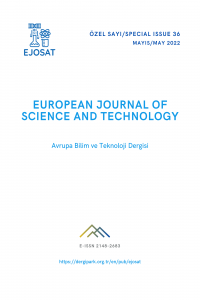Peumus boldus Yaprağı Ekstresi Kullanılarak Sentezlenen Bakır Nanopartiküllerin Antibakteriyel Aktivitesi
Abstract
Nanoparçacık elde etme yöntemlerinden biri olan yeşil sentez yöntemi, daha basit, çevreci, ekonomik olması ve kısa sürede ürüne dönüşmesi nedeniyle tercih edilen bir yöntemdir. Bu çalışmada, endemik bir bitki olan Peumus bolus'un ekstresi kullanılarak bakır nanopartikül (CuNp) sentez olanaklarının ve antimikrobiyal aktivitesinin araştırılması amaçlanmıştır. Sentezlenen CuNp’ler, taramalı elektron mikroskobu (SEM), Fourier transform kızılötesi spektrofotometre (FTIR) ve X-ışını kırınımı (XRD) ile karakterize edilmiştir. Başarılı bir şelilde sentezlenen NP’lerin 50 nm den küçük çapta olduğu küre şeklinde olduğu belirlenmiştir. CuNp’lerin antibakteriyel aktivitesi, broth seyreltme yöntemiyle test edilmiştir. Sonuçta Peumus boldus ekstraktı ile senetzlenen CuNp’lerin 125 ila 250 µgr/ml konsantrasyonlarda kullanıldığında E. coli ve S. aureus canlılıklarını %60 oranında baskıladığı görülmüştür.
References
- Asha, A. (2016). Green Synthesis of Silver Nanoparticle from Different Plants– A Review. International Journal of Pure & Applied Bioscience, 4(2), 118–124. https://doi.org/10.18782/2320-7051.2221
- Buzea, C., Pacheco, I. I., & Robbie, K. (2007). Nanomaterials and nanoparticles: Sources and toxicity. Biointerphases, 2(4), MR17–MR71. https://doi.org/10.1116/1.2815690
- Kathiravan, V., Ravi, S., & Ashokkumar, S. (2014). Synthesis of silver nanoparticles from Melia dubia leaf extract and their in vitro anticancer activity. Spectrochimica Acta - Part A: Molecular and Biomolecular Spectroscopy, 130, 116–121. https://doi.org/10.1016/j.saa.2014.03.107
- Kim, J. S., Kuk, E., Yu, K. N., Kim, J. H., Park, S. J., Lee, H. J., Kim, S. H., Park, Y. K., Park, Y. H., Hwang, C. Y., Kim, Y. K., Lee, Y. S., Jeong, D. H., & Cho, M. H. (2007). Antimicrobial effects of silver nanoparticles. Nanomedicine: Nanotechnology, Biology, and Medicine, 3(1), 95–101. https://doi.org/10.1016/j.nano.2006.12.001
- Lee, C., Kim, J. E. E. Y., Lee, W. O. N. I. L., & Nelson, K. L. (2008). Bactericidal Effect of Zero-Valent.pdf. 4927–4933.
- Saifuddin, N., Wong, C. W., & Yasumira, A. A. N. (2009). Rapid biosynthesis of silver nanoparticles using culture supernatant of bacteria with microwave irradiation. E-Journal of Chemistry, 6(1), 61–70. https://doi.org/10.1155/2009/734264
- Sapsford, K. E., Tyner, K. M., Dair, B. J., Deschamps, J. R., & Medintz, I. L. (2011). Analyzing nanomaterial bioconjugates: A review of current and emerging purification and characterization techniques. Analytical Chemistry, 83(12), 4453–4488. https://doi.org/10.1021/ac200853a
- Taleb, A., Petit, C., & Pileni, M. P. (1997). Synthesis of Highly Monodisperse Silver Nanoparticles from AOT Reverse Micelles: A Way to 2D and 3D Self-Organization. Chemistry of Materials, 9(4), 950–959. https://doi.org/10.1021/cm960513y
- Veisi, H., Rashtiani, A., & Barjasteh, V. (2016). Biosynthesis of palladium nanoparticles using Rosa canina fruit extract and their use as a heterogeneous and recyclable catalyst for Suzuki-Miyaura coupling reactions in water. Applied Organometallic Chemistry, 30(4), 231–235. https://doi.org/10.1002/aoc.3421
Abstract
The green synthesis method, which is one of the methods of obtaining nanoparticles; It is a preferred method because it is simpler, environmentally friendly, economical and turns into a product in a short time. In this study, it was aimed to investigate CuNp synthesis possibilities and antimicrobial activity of this Np by using the extract of Peumus boldus, an endemic plant. The synthesized CuNps were characterized by scanning electron microscopy (SEM), Fourier transform infrared spectrophotometer (FTIR) and X-ray diffraction (XRD). It was determined that the NPs synthesis was successful, and the overall geometry was spherical; besides, the diameters were less than 50 nm. The antibacterial activity of CuNps was tested by the broth dilution method. It was observed that CuNps synthesized with Peumus boldus extract used at 125 to 250 µgr/ml concentrations suppressed the viability of E. coli and S. aureus by 60%.
References
- Asha, A. (2016). Green Synthesis of Silver Nanoparticle from Different Plants– A Review. International Journal of Pure & Applied Bioscience, 4(2), 118–124. https://doi.org/10.18782/2320-7051.2221
- Buzea, C., Pacheco, I. I., & Robbie, K. (2007). Nanomaterials and nanoparticles: Sources and toxicity. Biointerphases, 2(4), MR17–MR71. https://doi.org/10.1116/1.2815690
- Kathiravan, V., Ravi, S., & Ashokkumar, S. (2014). Synthesis of silver nanoparticles from Melia dubia leaf extract and their in vitro anticancer activity. Spectrochimica Acta - Part A: Molecular and Biomolecular Spectroscopy, 130, 116–121. https://doi.org/10.1016/j.saa.2014.03.107
- Kim, J. S., Kuk, E., Yu, K. N., Kim, J. H., Park, S. J., Lee, H. J., Kim, S. H., Park, Y. K., Park, Y. H., Hwang, C. Y., Kim, Y. K., Lee, Y. S., Jeong, D. H., & Cho, M. H. (2007). Antimicrobial effects of silver nanoparticles. Nanomedicine: Nanotechnology, Biology, and Medicine, 3(1), 95–101. https://doi.org/10.1016/j.nano.2006.12.001
- Lee, C., Kim, J. E. E. Y., Lee, W. O. N. I. L., & Nelson, K. L. (2008). Bactericidal Effect of Zero-Valent.pdf. 4927–4933.
- Saifuddin, N., Wong, C. W., & Yasumira, A. A. N. (2009). Rapid biosynthesis of silver nanoparticles using culture supernatant of bacteria with microwave irradiation. E-Journal of Chemistry, 6(1), 61–70. https://doi.org/10.1155/2009/734264
- Sapsford, K. E., Tyner, K. M., Dair, B. J., Deschamps, J. R., & Medintz, I. L. (2011). Analyzing nanomaterial bioconjugates: A review of current and emerging purification and characterization techniques. Analytical Chemistry, 83(12), 4453–4488. https://doi.org/10.1021/ac200853a
- Taleb, A., Petit, C., & Pileni, M. P. (1997). Synthesis of Highly Monodisperse Silver Nanoparticles from AOT Reverse Micelles: A Way to 2D and 3D Self-Organization. Chemistry of Materials, 9(4), 950–959. https://doi.org/10.1021/cm960513y
- Veisi, H., Rashtiani, A., & Barjasteh, V. (2016). Biosynthesis of palladium nanoparticles using Rosa canina fruit extract and their use as a heterogeneous and recyclable catalyst for Suzuki-Miyaura coupling reactions in water. Applied Organometallic Chemistry, 30(4), 231–235. https://doi.org/10.1002/aoc.3421
Details
| Primary Language | English |
|---|---|
| Subjects | Engineering |
| Journal Section | Articles |
| Authors | |
| Early Pub Date | April 11, 2022 |
| Publication Date | May 31, 2022 |
| Published in Issue | Year 2022 Issue: 36 |


